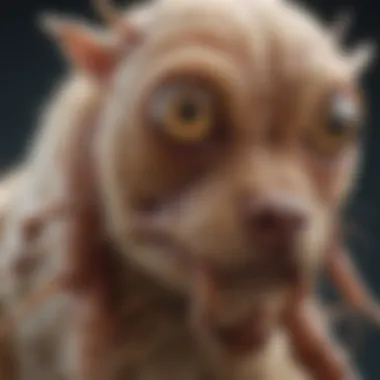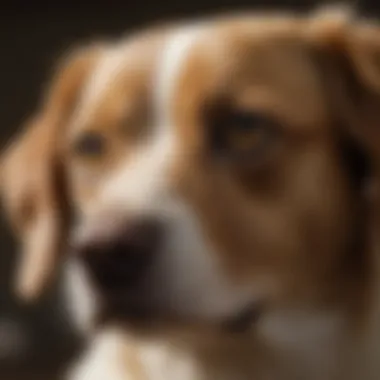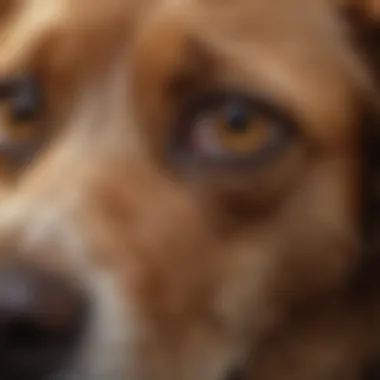Can Humans Contract Dog Lice: An In-depth Investigation


Animal Species Profile
When delving into the intricate world of lice infestation and the potential cross-species transmission between dogs and humans, it is imperative to understand the fundamental characteristics of these minuscule yet impactful parasites. While often associated with dogs, lice are wingless insects that thrive by feeding on the blood of their hosts. Their tiny size and specialized mouthparts facilitate this blood-feeding process.
Lice infestations, known as pediculosis, can vary among species, with specific types targeting distinct host animals. In the case of dogs, lice classifications typically include chewing lice (Trichodectes canis) and sucking lice (Linognathus setosus). These parasites adhere closely to the host's skin or fur, posing potential risks to the host's health and well-being.
The natural habitat and distribution of dog lice are intricately linked to the presence of their canine hosts. Dogs living in close proximity to other infested animals are at a higher risk of lice infestations. Ideal conditions for lice viability include temperate climates and suitable humidity levels, which are conducive to their survival and reproductive processes.
Behavior and social interactions within louse populations revolve around securing a host for feeding and reproduction. Lice require continuous access to their host's blood for sustenance, leading to persistent infestations if left untreated. Understanding the behavioral patterns of these parasites is essential in devising effective prevention and treatment strategies.
Stay tuned for the subsequent sections to unravel the intricacies of lice infestation, shedding light on potential risks and preventive measures for both dogs and humans.
Introduction
In the vast realm of parasitology, the interactions between humans, dogs, and lice have long intrigued researchers and pet owners alike. This article embarks on a scientific journey to decipher the possibility of humans contracting dog lice, encapsulating a nuanced exploration that traverses the realms of biology, veterinary science, and public health. By dissecting the intricate details of lice biology and transmission dynamics, we aim to shed light on the enigmatic question of cross-species lice infestation.
Lice, tiny wingless insects that thrive by feeding on the blood of their hosts, have been significant throughout human history, causing discomfort and disease. However, the potential transmission of lice from dogs to humans adds a new dimension to the age-old struggle against these persistent parasites. Understanding the mechanisms behind lice infestations in dogs and their hypothetical transfer to humans is crucial for both pet care and human health. By unraveling these complexities, we can better equip ourselves to safeguard our furry companions and ourselves from the scourge of lice infestation.
With meticulous attention to detail, we will dissect the various types of lice that affect dogs, exploring their biology, life cycle, and potential impact on human health. By mapping out the landscape of lice infestations in dogs, we can draw parallels to understand the hypothetical risks posed to humans. This exploration serves as an essential guide for pet owners, animal enthusiasts, and health professionals alike, offering a unique perspective on the intricate interplay between lice, dogs, and humans.
Understanding Lice


Understanding lice holds a crucial position in this article due to its intricate role in the transmission of lice from dogs to humans. By comprehending the nature of lice, their various types, and life cycle, readers can grasp the potential risks associated with human-dog interactions. This knowledge equips individuals with the necessary information to identify, prevent, and address lice infestations effectively, safeguarding both human and canine health.
Types of Lice
The Head Louse
The Head Louse plays a significant role in this discussion as it is commonly associated with infestations in humans, making it a pertinent aspect to explore in the context of dog lice. Its key characteristic lies in its preference for the scalp area, leading to localized infestations that can spread if not managed promptly. In this article, delving into the specifics of the Head Louse sheds light on potential cross-species transmission risks and underscores the importance of early detection and treatment to mitigate infestation risks effectively.
The Body Louse
Within the realm of understanding lice, the Body Louse holds relevance due to its tendency to infest clothing and bedding, facilitating easy transmission between hosts. Its distinctive feature of residing primarily in clothing sets it apart from other types of lice, posing challenges in eradication and prevention efforts. By dissecting the characteristics and behaviors of the Body Louse, this article aims to highlight the comprehensive nature of lice infestations and the varying strategies required for effective control and prevention.
The Pubic Louse
Exploring the Pubic Louse in the context of lice understanding provides valuable insights into a specific type of lice infestation that carries distinct implications for human health. Its preference for the genital region poses unique challenges in detection and treatment, making it essential to address in discussions about lice control. By elaborating on the characteristics and effects of the Pubic Louse, this article aims to enhance awareness about the diversity of lice species and the nuanced approaches needed to tackle infestations comprehensively.
Life Cycle of Lice
Egg (Nit) Stage
The Egg (Nit) Stage plays a foundational role in the life cycle of lice, representing the starting point of infestation and growth. Understanding this stage is critical as it underscores the need for thorough removal to prevent further infestation cycles. By elucidating the characteristics and behaviors of lice eggs, this article aims to equip readers with the knowledge required to identify and address infestations at their source effectively.
Nymph Stage


Transitioning into the Nymph Stage signifies a crucial phase in the lice life cycle, indicating maturation and reproductive capabilities. This stage poses heightened risks of infestation spread, necessitating targeted intervention strategies to curb population growth. By detailing the features and implications of the Nymph Stage, this article enhances readers' understanding of lice development and the strategic approaches needed to break the infestation cycle successfully.
Adult Stage
The Adult Stage marks the culmination of the lice life cycle, highlighting the full-grown reproductive phase of the parasites. Exploring this stage sheds light on mating behaviors, infestation longevity, and transmission risks linked to adult lice. By examining the unique characteristics and behaviors of adult lice, this article aims to provide a comprehensive overview of the lice life cycle, enabling readers to identify key intervention points and preventive measures to combat infestations effectively.
Lice in Dogs
Lice in dogs is a crucial topic in this article as it examines the potential for humans to acquire dog lice. Understanding the presence of lice in dogs is essential for comprehending the risks of transmission to humans. By delving into the types of lice that affect dogs and the implications for human health, this section sheds light on the interconnected nature of lice infestations across species.
Can Dogs Get Lice?
There is a common misconception that only humans can get lice, but dogs are also susceptible to these pesky parasites. While the likelihood of lice infestations in dogs is relatively low compared to humans, it is still possible for them to get lice. Dogs can contract lice from other infested animals or environments, making it vital for pet owners to remain vigilant and proactive in preventing and addressing lice issues in their furry companions.
Types of Lice in Dogs
Trichodectes canis (Chewing Lice)
Trichodectes canis, commonly known as Chewing Lice, displays a unique feeding behavior by biting and chewing on the host's skin and hair. These lice are specialized for dogs and can cause discomfort and itching in infested animals. Understanding the characteristics of Trichodectes canis is crucial for identifying and treating lice infestations in dogs effectively.
Linognathus setosus (Sucking Lice)


Linognathus setosus, or Sucking Lice, feed by piercing the host's skin and sucking blood for nourishment. These lice have adapted to dogs as their primary hosts, posing health risks and irritation. Exploring the attributes of Linognathus setosus provides insights into the unique challenges posed by sucking lice infestations in dogs and emphasizes the importance of preventive measures to safeguard against these parasites.
Potential Transmission to Humans
In the realm of potential transmission to humans, the intricacies of lice movement between canines and humans come to light. This section serves as a pivotal juncture in our exploration, shedding light on the crossroads where dog lice could surprisingly find their way onto human hosts. As we dissect this phenomenon meticulously, it becomes evident that understanding the potential transmission of lice from dogs to humans is crucial in safeguarding human health and maintaining harmonious coexistence with our furry companions.
Unveiling the enigmatic realm where lice leap species boundaries, we uncover the subtle yet significant risks posed by these parasites and the need for vigilant awareness among pet owners and wildlife enthusiasts. The interconnection between lice infestations in canines and their potential migration to human populations underscores the relevance of this discussion. By scrutinizing this facet, we equip ourselves with the knowledge required to mitigate potential health hazards and preserve the well-being of both humans and their beloved pets.
Analyzing the factors that contribute to the transfer of lice from dogs to humans emphasizes the importance of preventive measures and proactive intervention. Through a comprehensive examination of lice biology and behavioral patterns, we gain insights into the mechanisms underlying interspecies transmission. By unraveling the complexities of lice transmission dynamics, we empower ourselves to implement effective strategies that impede the proliferation of these parasitic organisms across species boundaries.
Embarking on a journey through the intricate pathways of potential lice transmission, we navigate the subtle nuances that dictate the interplay between canines and humans in the context of parasitic infestations. By illuminating the potential risks and repercussions of lice transfer, we underscore the significance of vigilance and preemptive action in mitigating the spread of these microscopic adversaries. This section stands as a beacon of awareness, guiding readers through the delicate ecosystem of lice transmission and equipping them with the tools to protect themselves and their four-legged companions from potential harm.
Risks and Prevention
Risk assessment and prevention are pivotal components addressed in this comprehensive exploration of the potential transmission of lice from dogs to humans. Understanding the inherent risks associated with lice infestations in dogs not only sheds light on their implications for human health but also underscores the importance of proactive measures to mitigate such risks. By elucidating these crucial aspects, this article equips readers with the knowledge needed to safeguard themselves and their pets against the potential hazards of lice transmission. Health Risks Associated with Lice
Adverse health effects stemming from lice infestations are a pertinent concern for both dogs and humans. Lice infestations may lead to skin irritation, allergic reactions, and in severe cases, dermatitis. Transmission of pathogens by infected lice further escalates the health risks, emphasizing the importance of early identification and treatment. By exploring the various health risks associated with lice infestations comprehensively, this article empowers readers to recognize the symptoms and seek appropriate interventions promptly. Preventive Measures for Humans
In the realm of lice infestations, preventive measures play a crucial role in averting potential health hazards. Two primary preventive strategies for humans are regular pet inspections and maintaining personal hygiene. These preventive measures not only minimize the risk of lice transmission but also contribute to overall well-being. By engaging in systematic inspections and upholding robust personal hygiene practices, individuals can create a protective barrier against lice infestations, fostering a safe environment for themselves and their beloved pets. Regular Pet Inspections
Regular pet inspections form a cornerstone of lice prevention efforts, enabling pet owners to detect early signs of infestation and intervene promptly. By conducting thorough examinations of their pets' fur and skin, individuals can identify lice or nits, facilitating timely treatment to prevent further escalation. The meticulous nature of regular pet inspections offers a proactive approach to lice management, fostering a vigilant stance against potential infestations in both pets and humans. While these inspections demand commitment and diligence, their efficacy in preempting lice transmission underscores their indispensable role in maintaining optimal pet and human health and well-being. Maintaining Personal Hygiene
Maintaining personal hygiene is a fundamental aspect of lice prevention, as it mitigates the likelihood of lice infestations in humans. Practices such as regular bathing, laundering of clothing and bedding, and avoiding shared personal items can significantly reduce the risk of lice transmission. By upholding stringent personal hygiene standards, individuals not only protect themselves from potential infestations but also contribute to the broader effort of curbing the spread of lice. The practicality and efficacy of maintaining personal hygiene make it a cornerstone of preventive strategies, underscoring its critical role in preserving optimal health for both individuals and their animal companions.
Conclusion
Highlighting the essence of the conclusion, it becomes evident that preemptive action based on information garnered in this exploration holds the key to mitigating risks associated with lice transmission. Through consistent pet inspections and an emphasis on personal hygiene, individuals can safeguard themselves and their furry companions against the distress caused by lice infestations. The interplay between these preventive actions and the foundation laid by scientific knowledge exemplifies the synergy between theoretical understanding and practical application, creating a harmonious environment for both humans and dogs.
Transitioning from the theoretical realm of lice biology to the tangible realm of health risks reinforces the holistic approach required to tackle this issue effectively. Furthermore, by underlining the symbiotic relationship between humans and dogs in the context of lice transmission, this exploration not only informs but also empowers readers to take charge of their well-being and that of their beloved pets with confidence and proactivity.







